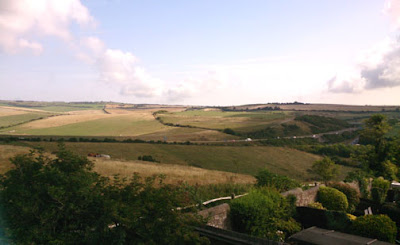A New Starting Point 20 - 22 August Foredown Tower - part the second
One of the many beautiful views from Foredown Tower
So . . . onto part 2.
A New Starting Point includes making faux chenille with newspaper. The group layered eight sheets of A4 newspaper with polyester organza. Using contrasting colours of paper and organza can create some very colourful samples. The layers of newspaper need to have some support otherwise your work will fall apart. Adding a sew-in interfacing such as classic pelmet Vilene (S80/239) or the 'pelmet Vilene light' to the back of your work - Vilene interfacings will re enforce your work. Once you have stacked your layers up you then machine stitch 'tramlines' across the whole sample, your 'channels' need to be at least 1/2 inch apart. If the 'channels' are too close together you wont be able get your scissors down the 'channels' to cut them.
Another tip when stitching newspaper faux chenille is to use a long stitch, the longest your machine will do - usually no 4. Once you have stitched your sample you then cut down the channels with a pair of scissors (not your best ones) or a special rotary cutter that has an extension specifically for cutting faux chenille. You can then 'scuff' up the resulting cut sample. you can use a scrubbing brush, a suede brush, your fingers . . . but whatever you do, do it gently - your work will be perforated with lots of little holes
Jean wading through her piles of newspaper and painted Bondaweb.
After the faux cehenille it was onto making the samples to cut the jewellery blanks from. The layered and decorated newspaper from the previous post was ironed onto S133, the heaviest iron-on interfacing. This process makes colourful, light weight jewellery. The S133 can be cut with scissors or a scalpel but you get a better finish if you can lay your hands on a die cutting machine.
Diane using my Big Shot Pro die cutting machine to cut here jewellery blanks. It is big enough to use the 12" dies, but if you are only using the smaller 6" dies for the smaller shapes, you can use a basic Big Shot die cutting machine.
I didn't want to go into a full jewellery making class by making up the earrings and brooches - that would be another course, at least another day. However, I think you can see the potential in all the shapes above.Jean ironed her black and white newspaper sample onto the new Decovil 1 light - a soft, leather like iron-on interfacing. She cut this box shape with a pair of scissors and will use the flower shape as part of the clasp.
Many of you will know that I love older sewing machines, my Bernina 707 is usually the oldest in the room - but not this time - Jean bought in her Bernina 530 - 2, it's older than me and just purrs as it stitches - just wonderful.
A beautiful old Bernina 530-2.
So that's if for now - I'm off to muck out my cutting room . .
enjoy the rest of the day.
*
Hello Jill, Diana (no squinting now) and Robbie!!
x x x





























Comments
Post a Comment